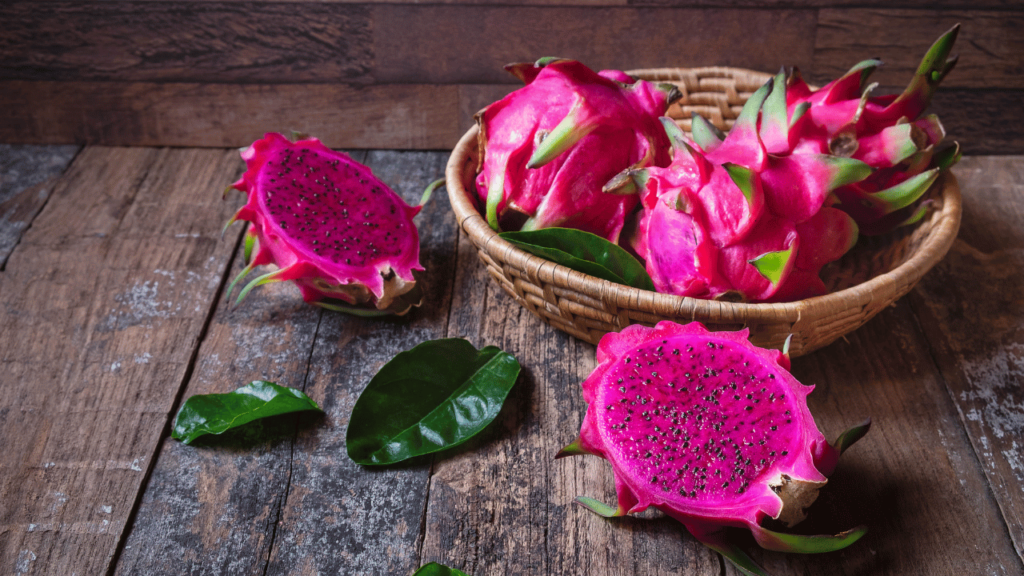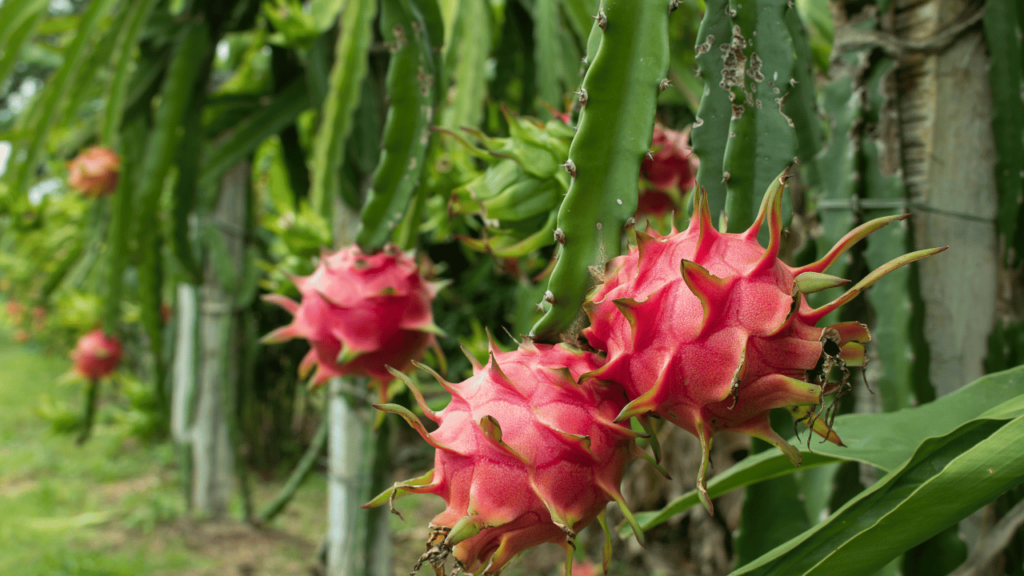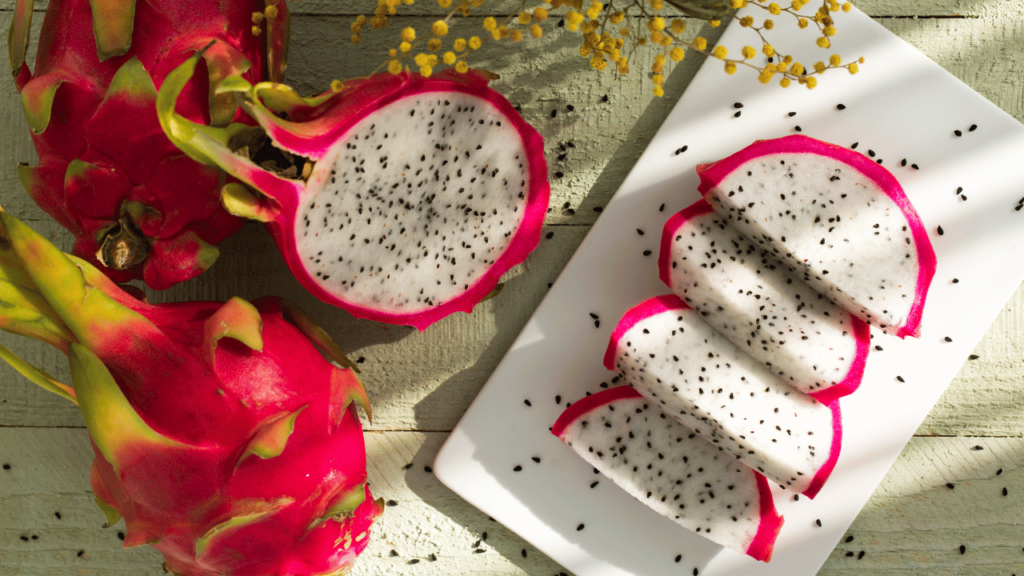Fresh Dragon Fruit, Health Benefits and Side Effects in 2023
Fresh Dragon fruit
Fresh Dragon fruit, also known as pitaya, is a tropical fruit that grows on various species of cactus. It has a vibrant and unique appearance, with a bright pink or yellow outer skin covered in green scales. When you cut it open, you’ll find a white or pink fleshy interior speckled with tiny black seeds. The texture of dragon fruit is often compared to that of a kiwi, with a mildly sweet and refreshing flavor. It’s not only delicious but also packed with nutrients like vitamin C, fiber, and antioxidants. Dragon fruit can be enjoyed on its own, added to smoothies, used in salads, or even made into desserts. It’s a fun and exotic fruit that’s definitely worth trying.

How Dragon fruit grow on Dragon Fruit Plant
Dragon fruit grows on several species of cactus, including the Hylocereus and Selenicereus varieties. The cactus plants typically have sprawling, vining stems that can grow up to several meters in length. The flowers of the cactus are large and showy, opening at night and often pollinated by bats or moths. Once the flowers are pollinated, they develop into fruit, which takes about 30-50 days to mature. The fruit grows directly from the stems of the cactus, and as it ripens, it changes color from green to vibrant pink or yellow.

When the fruit is ready to be harvested, it can be easily plucked from the cactus. Dragon fruit plants are relatively easy to grow, and they thrive in warm, tropical climates. Dragon fruit, also known as pitaya, is a tropical fruit that grows on several species of cactus. It can be cultivated both in the ground and in containers.
Over the years, its popularity has grown, and it can now be found in many countries around the world.The dragon fruit has a taste and texture similar to a combination of watermelon and kiwi. If you’re interested in growing dragon fruit, you can start by obtaining a cutting from an existing plant and planting it in well-draining soil. With proper care and attention, you can enjoy the beauty and deliciousness of homegrown dragon fruit.
Cultivation Of Dragon Fruit
Dragon fruit is primarily found in countries with warm and tropical climates. It is native to Central America and is commonly grown in countries such as Mexico, Nicaragua, and Costa Rica. It is also cultivated in Southeast Asian countries like Vietnam, Thailand, and the Philippines. Additionally, dragon fruit is grown in parts of Australia, Israel, and some regions of the United States like California and Florida. The popularity of dragon fruit has spread, and it can now be found in many countries around the world. It’s a fascinating fruit with a global presence.
Types Of Dragon Fruit
There are different types of Dragon Fruit Some of them are given below:
- White-fleshed dragon fruit (Hylocereus undatus): This variety has a vibrant pink or yellow skin with green scales. The flesh is white and has a sweet, mild flavor. It’s often described as being similar to a cross between a kiwi and a pear.
- Red-fleshed dragon fruit (Hylocereus costaricensis): This type has a striking red or magenta skin with green scales. The flesh is deep red and has a slightly sweeter taste compared to the white-fleshed variety. It’s often described as being similar to a mix of watermelon and kiwi.
- Yellow dragon fruit (Hylocereus megalanthus): This variety stands out with its bright yellow skin and green scales. The flesh is white with small black seeds and has a tangy, tropical flavor. It’s often described as a blend of pineapple and citrus.
These different types of dragon fruit offer a variety of flavors and colors, making them a delightful addition to any fruit salad or smoothie.
Health Benefits Of Dragon Fruit
Dragon fruit offers several health benefits. Here are a few:
- Rich in antioxidants: Dragon fruit is packed with antioxidants, which help protect your cells from damage caused by harmful free radicals.
- High in vitamin C: Dragon fruit is an excellent source of vitamin C, which is important for immune function, collagen production, and iron absorption.
- Good source of fiber: Dragon fruit contains a good amount of dietary fiber, which can help promote healthy digestion and prevent constipation.

- Low in calories: Dragon fruit is relatively low in calories, making it a great option for those watching their calorie intake.
- Hydrating properties: Dragon fruit has a high water content, which can help keep you hydrated and support overall well-being.
- Potential anti-inflammatory effects: Some studies suggest that dragon fruit may have anti-inflammatory properties, which can help reduce inflammation in the body.
Remember, it’s always a good idea to incorporate a variety of fruits and vegetables into your diet for optimal health.
Dishes Of Dragon Fruit
Dragon fruit is a versatile fruit that can be used in a variety of dishes. Here are a few popular ways to enjoy dragon fruit:
- Smoothies and smoothie bowls: Dragon fruit adds a vibrant color and a refreshing taste to smoothies. Blend it with other fruits like bananas, berries, or mangoes for a delicious and nutritious treat. You can also use dragon fruit as a topping for smoothie bowls.
- Salads: Dragon fruit can be sliced and added to salads for a pop of color and a subtle sweetness. It pairs well with greens, citrus fruits, and a light dressing.
- Desserts: Dragon fruit can be used in desserts like fruit tarts, sorbets, and even ice cream. It adds a unique flavor and a beautiful pink hue to these sweet treats.
- Cocktails and mocktails: Dragon fruit can be muddled or blended into drinks to create colorful and refreshing beverages. It works well in tropical cocktails or as a garnish for mocktails.
These are just a few examples, but the possibilities are endless when it comes to using dragon fruit in your culinary creations. Get creative and enjoy the unique flavor and vibrant appearance of this exotic fruit.
Side Effects Of Dragon Fruit
Dragon fruit is generally safe to consume, but like any food, it may have some side effects for certain individuals. Here are a few things to keep in mind:
- Allergies: Some people may be allergic to dragon fruit, although this is rare.It is important to note that if you have a known allergy to other fruits, it is best to consult with a healthcare professional before trying dragon fruit.
- Digestive issues: Dragon fruit contains dietary fiber, which can help promote healthy digestion. However, consuming too much fiber at once may cause digestive discomfort, such as bloating or gas. It’s always a good idea to introduce new foods gradually and in moderation.
- Medication interactions: If you’re taking any medications, it’s advisable to consult with your healthcare provider before consuming dragon fruit. Some compounds in the fruit may interact with certain medications, so it’s important to ensure there are no potential conflicts.
Remember, these side effects are not very common, and most people can enjoy dragon fruit without any issues. As with any new food, it’s a good idea to listen to your body and consume it in moderation. Additionally, if you have any specific concerns or medical conditions, it is best to consult with a healthcare professional to ensure it is safe for you to consume dragon fruit.